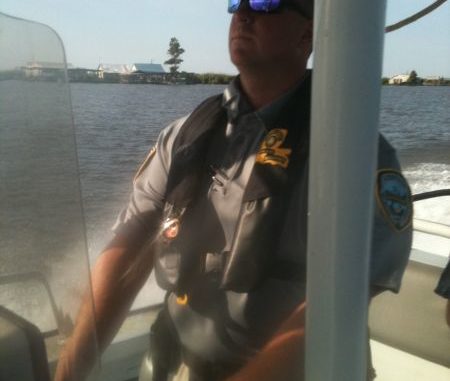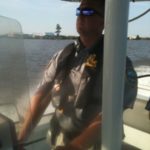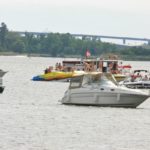
Alcohol, boating don’t mix
With kids out of school and the summer boating season well under way, boat traffic will be heavy on waters everywhere.
For wildlife agents, patrol activity will focus on boating safety on popular lakes, rivers and streams.
The four primary concerns are safety inspections, impaired operators, boating-accident investigations, and search and rescue.
All four are important tasks, which when successfully achieved result in a better and safer boating environment.
The important thing to remember is that if wildlife agents get the first two done right, the last two are seldom required.
But what’s also interesting about those four tasks is that it’s not unusual for a typical day on patrol to involve all four.
During a busy summer weekend on the water, an agent’s patrol begins around midday. Fishermen are usually heading in, so it is a good time to have a look at creel limits and perform safety inspections on fishing boats.
At the same time, recreational boaters, water skiers and personal watercraft enthusiasts are beginning to show up.
Through the early afternoon hours, agents continue to perform safety inspections. As the day wears on, more time will be devoted to monitoring activity than actually making random inspection stops; the emphasis has now shifted to careless or reckless operation, often an indication of an impaired operator.
When dangerous operation or excessive speed is observed, agents stop the boat to check the operator for sobriety. If the operator is under the influence, agents make an arrest and begin constructing a case for boating under the influence.
If the operator is not impaired, agents might simply caution him or her, but citations will be issued when deemed necessary.
Often, the mere presence of agents on a lake or river is enough to get compliance with boating laws, safe operation and sobriety. High visibility on the part of agents has a way of making some folks better and safer boaters, and cell phones help spread the word when agents are on the lake. So on smaller lakes agents might make a brief visit at one, and then move to another in an effort to be seen in as many places as possible.
It keeps things quiet.
Boating accidents typically occur in late afternoons or evenings.
There are a number of reasons why. Hours of exposure to sun, wind and heat — sometimes in combination with the effects of alcohol — tend to make people less alert. Some might be in a hurry to get in to the launch ahead of the crowd or before dark.
A high number of boats and personal watercraft can congregate at or near a launch, increasing the chances of collision.
Operating in the dark increases the risk of collision with fixed objects or other boats.
Whatever the reasons, this is when many accidents take place.
When a serious accident does occur, agents must respond to the scene, sometimes in combination with EMS, local law enforcement and the Coast Guard.
Accidents involving serious injuries or death require a comprehensive investigation, and it is not unusual for the district supervisor and several agents to work the accident.
During the initial response to the location of the accident, a number of factors must be determined. What happened? When? How many people are involved and who are they? Is anyone missing? Has anyone left the scene or been taken to the hospital? If so where are they? Are there any witnesses? How many boats are involved and where are they?
If any victims are missing and presumed to be in the water, search and rescue operations are begun immediately.
If this isn’t required, the first orders of business are statements from witnesses and victims and securing the boats and equipment. Statements from those involved will often reveal what happened and why.
In those situations where no one is left alive to give a statement or when witness statements conflict, reconstructing the accident might be the only way to determine what happened and where. This is why securing the boats is very important.
I recall one accident investigation where two boats had collided in a narrow waterway. One of the boats ran over the top of the other vessel, killing the operator.
The surviving operator claimed the collision had occurred in a curve and was unavoidable. In his statement, the operator said the other boat suddenly came into view as it rounded the curve and was on the wrong side of the bayou and directly in his path.
The evidence said otherwise.
Agents noticed pieces of metal railing running the length of the gunnels on the deceased operator’s boat were missing.
Among the investigating agents was one trained in SCUBA diving and underwater evidence recovery. After meticulously searching the area for several days, he located the missing railing.
But it was not where the surviving operator claimed the collision occurred. Rather it was in a straight section of the bayou, upstream from the alleged crash site and near the right ascending shoreline, where the deceased operator should have been (and was) travelling in compliance with the “rules of the road.”
Securing the equipment, thoroughly investigating and reconstructing the accident led to the truth.
Another important patrol task is search and rescue for missing or overdue boaters. Engine failure, running out of fuel or simply getting lost are common occurrences that leave boaters stranded.
In most situations, the wildlife agent’s familiarity with the local waterways lends itself to quickly locating the missing. But every boater should carry distress signals, and items such as rain gear, a flashlight and insect repellent. Be prepared in case it takes a while for rescue to arrive; don’t rely totally on the cell phone because they aren’t much good if the batteries go dead or you are in areas without coverage.
When search-and-rescue efforts must be expanded or extended, wildlife agents typically partner with local law enforcement, the Coast Guard and volunteers to get the job done. Louisiana’s wildlife agents are recognized as experienced leaders in coordinating these operations.
Wildlife agents are well-trained and equipped to patrol our waterways. But responsible boaters need to do their part, as well. So make sure your equipment is in good condition, and take the time to get the proper boat safety training.
And remember that everyone born after Jan. 1, 1984, is required to complete a NASBLA-approved boating education course before operating a motorboat over 10 horsepower and must carry proof of such when operating the motorboat.
A motorboat may be operated if any person on board or participating in any boating activity from the motorboat is over 18 and, if required, has completed the required boating safety course.
LDWF offers boating classes all over the state free of charge to the public. I encourage everyone to take the course. See the 2016 Louisiana Fishing Regulations booklet or visit www.wlf.louisiana.gov for more information.
Got a question? Ask Keith!
If you have a question about wildlife and fisheries enforcement, shoot a note to Keith LaCaze at klacaze15@att.net.




